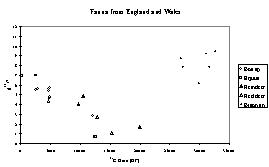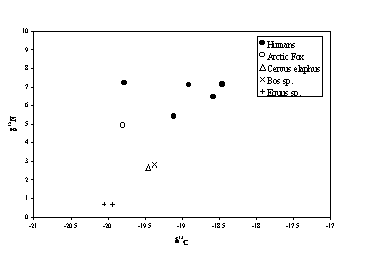
Stable isotope analysis for climate and palaeodietary reconstruction
Stable isotope analysis is an integral part of the AHOB program, providing information on past environments and mapping changing faunal and hominid dietary adaptations through time. Stable isotope analyses is at an exciting stage in it's development, allowing fairly routine measurements of carbon and nitrogen in collagen for important dietary information, as well as providing the promise of new information from isotopes of other elements in bone, such as oxygen. The AHOB project is an ideal framework in which to apply the more established areas of isotope analysis as well as help develop these new areas.
The AHOB project will uniquely provide a very large dataset of new stable isotope measurements of oxygen, carbon and nitrogen in faunal and hominid remains. The data produced from this project will significantly increase the dataset of stable isotope values for the UK.
(1) Stable isotope analysis of oxygen, for climate reconstruction
Bone mineral and dental enamel oxygen isotope values reflect the oxygen isotope values of the water that a mammal consumes. If that mammal is migratory between climatic zones that have very different oxygen isotope ratios then the different values may be recorded in the bone or enamel. Therefore, oxygen isotopes have the potential to identify migrating species or humans. For example, if reindeer travel great distances between distinct climatic zones in a year their antlers may record the different O isotope values of the different regions. If a human child lived in one climatic zone, and then moved as an adult to another, the tooth O isotope values will reflect childhood location, and the bone will indicate adult locality.
A more common use of O isotopes, largely from enamel, is to indicate the changing climate in a specific region, as similar species who are known to be non-migratory will record the current climate in their enamel, and in a sequence from the same area these values can be compared with enamel O isotope values of the same or similar non-migratory species from earlier or later contexts to indicate how the climate has changed.
There are many exciting possibilities with oxygen isotopes of bone and enamel, but there are also serious concerns over contamination of bone and enamel by soil and groundwater oxygen. Generally, enamel has been shown to be much more immune to contamination than bone, but this is a potential problem that needs to be addressed. There are ways to design the experiments to address the archaeological and palaeoenvironmental questions of interest, as well as indicate if diagenesis and contamination of the samples has occurred.
Problems with possible contamination are one of the main reasons for exploring the use of oxygen isotopes in bone collagen, as collagen is a lot more stable and less prone to contamination (see above). Although oxygen is also present in collagen, collagen oxygen isotope ratios have never been measured. This is due to a number of technical factors, but recent advances in mass spectrometry now open up this possibility.
(2) Stable isotope analysis of carbon and nitrogen for climate and palaeodietary reconstruction
From bone and tooth collagen we can routinely obtain carbon and nitrogen stable isotope values, which tells us mainly about the past diets of humans and fauna. Collagen likely reflects the isotope values of dietary protein over the long term (10 years or so, depending in the bone element). The carbon isotope measurements will tell us mainly about the amount of protein in the diets from terrestrial vs. marine ecosystems while the nitrogen isotopes reflect the trophic level of the protein that has been consumed, and within a single ecosystem can identify herbivores and carnivores, and the diets of omnivores, such as hominids. Members of the AHOB team have used carbon and nitrogen stable isotope values to demonstrate that late Upper Palaeolithic humans from Gough's and Sun Hole caves had a predominately animal protein based diet.
Figure 1: Plot of human and faunal stable isotope values from Gough's and Sun Hole Caves (taken from Richards et al. (2000), Journal of Archaeological Science 27:1-3.
Additionally, C and N isotopes can tell us about climate variation. Preliminary
data clearly show a change in herbivore C and N isotopes in Britain through
time, likely linked to climate variation, especially in carbon (Figure
2, 3).
The use of C and N isotopes in bone collagen may be a very important new development in palaeoclimatic reconstruction if bone can provide robust environmental signals in areas where there is a good faunal sequence, but not suitable lake or marine sediment sequences. Additionally the isotope climate signal from these fauna can be linked in with faunal abundance studies and biostratigraphy. But, we need a great deal more data to realise the environmental reconstruction possibilities of bone collagen C and N isotopes, and the AHOB can provide this.


Figure 2: d13C and d15N values of bone collagen of various faunal species from England and Wales plotted against the radiocarbon age of the collagen (Taken from Richards,1998. Unpublished D.Phil. dissertation, University of Oxford).
![]()
